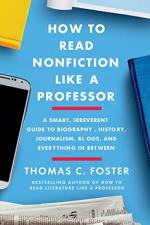
|
| Name: _________________________ | Period: ___________________ |
This test consists of 5 multiple choice questions, 5 short answer questions, and 10 short essay questions.
Multiple Choice Questions
1. In Chapter 8, "Bringing the News," Foster says that All the President's Men is sui generis. He is saying that this book is what?
(a) Challenging.
(b) Revealing.
(c) Unique.
(d) Uplifting.
2. In Chapter 2, "The Ecology of the Nonfiction Biosphere," what does Foster say is the difference between "hard news" and "soft news"?
(a) Hard news is focused on statistics and data; soft news is focused on investigations and exposés.
(b) Hard news is fact-focused, basic news gathering; soft news is generally lengthier and less objective.
(c) Hard news is truth-focused; soft news permits some inaccuracy.
(d) Hard news is focused on difficult truths; soft news is about making the reader feel good.
3. In Chapter 5, "It May Just Be Me, But..." what does Foster say about offering equal space and analysis to opposing arguments?
(a) This can destroy a story.
(b) This is part of fair and balanced reporting.
(c) It strikes the modern reader as dishonest.
(d) It is confusing to the reader.
4. In Chapter 2, "The Ecology of the Nonfiction Biosphere," Foster calls an expression a "bromide." What is he saying about this expression?
(a) It is boring and mean-spirited.
(b) It is clever and concise.
(c) It is unoriginal and unimportant.
(d) It is insightful but wordy.
5. In Chapter 8, "Bringing the News," Foster maintains that types of newspaper writing like advice columns and human interest stories exist for what reason?
(a) To fill up space not needed for daily news.
(b) Because readers can not live without them.
(c) Because they are traditional.
(d) To sell newspaper advertising.
Short Answer Questions
1. According to "The Building Blocks of Arguments," what are the "grounds" of a argument?
2. In Chapter 2, "The Ecology of the Nonfiction Biosphere," what does Foster say is the point of having a variety of media sources?
3. In Chapter 2, "The Ecology of the Nonfiction Biosphere," Foster notes that the expectation for a writer to be engaging does not apply to which types of writing?
4. In Chapter 1, "The Structure of Nonfiction Information," what does Foster mean when he uses the word "dichotomy"?
5. In Chapter 2, "The Ecology of the Nonfiction Biosphere," what does Foster call the rules governing different forms of nonfiction?
Short Essay Questions
1. In Chapter 6, "Source Code," what does Foster say is the consequence of a "land without gatekeepers" (68)?
2. In Chapter 1, "The Structure of Nonfiction Information," what does Foster say is the purpose of his reader being asked to think like a writer, and what is one example of how this works?
3. In Chapter 5, "It May Just Be Me, But..." how does Foster suggest that a reader can examine the author's use of quotes to determine bias?
4. Why, in Chapter 2, "The Ecology of the Nonfiction Biosphere," does Foster say that it is both good and bad news that all communication has a "grammar"?
5. In Chapter 6, "Source Code," what two problems does Foster identify with the use of data as support?
6. In Chapter 7, "All in How You Look at Things," what does Foster compare to "wrestl[ing] an octopus," (81), and why does he make this comparison?
7. In Chapter 6, "Source Code," what does Foster say about biographies and the length of time that has passed since the lives of their subjects?
8. In Chapter 6, "Source Code," what does Foster say that "expertise" is and is not?
9. At the end of "Building Blocks of Arguments," Foster discusses mistakes in claims, grounds, and warrants. He gives the example of someone born in American Samoa claiming to be a U.S. citizen. Since American Samoa is not a territory that the U.S. recognizes as conferring birthright citizenship, Foster says that this argument is mistaken in its grounds. Is it? Explain why or why not.
10. In Chapter 7, "All in How You Look at Things," what are the ways that Foster suggests chronological order can be modified, and why would a writer choose to do this?
|
This section contains 1,161 words (approx. 4 pages at 300 words per page) |

|




